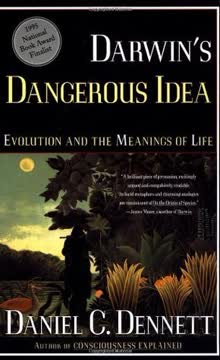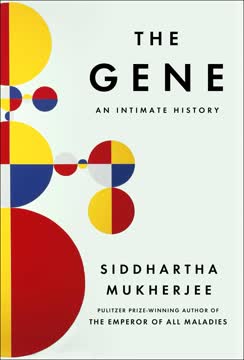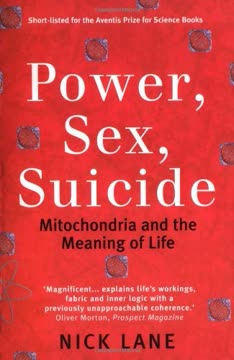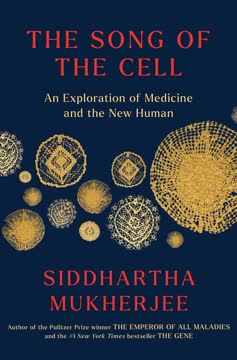Points clés
1. Notre génome est un livre de la vie, écrit en code numérique
Le génome humain est un livre... Il y a vingt-trois chapitres, appelés CHROMOSOMES. Chaque chapitre contient plusieurs milliers d'histoires, appelées GÈNES.
Langage numérique de la vie. Le génome est fondamentalement un système d'information, encodé dans l'alphabet à quatre lettres de l'ADN (A, C, G, T). Ce code numérique contient les instructions pour construire et faire fonctionner un être humain. La structure du génome ressemble à un livre :
- 23 chromosomes ("chapitres")
- 20 000 à 25 000 gènes ("histoires")
- 3 milliards de paires de bases d'ADN ("lettres")
Comme le code informatique, le génome peut être lu, copié et même édité. Cette nature numérique permet une réplication précise et une transmission de l'information génétique à travers les générations.
2. Nous partageons un ancêtre commun avec tous les êtres vivants
Les mouches et les humains ne sont que des variations sur un thème de construction corporelle établi par une créature semblable à un ver au cours de la période cambrienne.
Unité de la vie. Toute vie sur Terre partage un ancêtre commun et utilise le même code génétique. Cela explique pourquoi :
- De nombreux gènes sont conservés à travers des espèces très différentes
- Nous pouvons étudier les mouches à fruits ou les souris pour en apprendre sur la biologie humaine
- L'ingénierie génétique peut transférer des gènes entre espèces
Les similitudes dans les mécanismes génétiques à travers les formes de vie fournissent des preuves convaincantes de l'évolution et de notre connexion profonde à tous les êtres vivants.
3. Les gènes ne sont pas seulement responsables des maladies, mais façonnent notre biologie entière
LES GÈNES NE SONT PAS LÀ POUR CAUSER DES MALADIES.
Les gènes comme instructions. Bien que nous nous concentrions souvent sur les mutations causant des maladies, les gènes encodent principalement les instructions pour les fonctions biologiques normales :
- Construire et maintenir nos corps
- Réguler les processus physiologiques
- Influencer le comportement et les traits cognitifs
Les gènes associés aux maladies représentent généralement des variantes de gènes normaux ayant des fonctions essentielles. Comprendre ces fonctions normales est crucial pour faire progresser la biologie et la médecine.
4. La nature et la culture interagissent de manière complexe pour influencer nos traits
Loin de nous laisser à la merci de nos gènes omnipotents, ce sont souvent nos gènes qui sont à notre merci.
Interaction gène-environnement. Nos traits résultent d'interactions complexes entre nos gènes et l'environnement :
- Les gènes peuvent influencer notre réponse aux facteurs environnementaux
- Les facteurs environnementaux peuvent influencer l'expression des gènes
- Certains gènes affectent notre propension à rechercher certains environnements
Cette interaction signifie que ni les gènes ni l'environnement seuls ne déterminent notre destin. Comprendre ces interactions est essentiel pour démêler les complexités de la biologie et du comportement humains.
5. Le génome humain contient des vestiges de notre passé évolutif
Nous sommes remplis de chaînes de lettres numériques et d'avertissements sur la marmelade.
Fossiles génomiques. Notre génome est un document historique, contenant :
- Des vestiges de virus anciens
- Des gènes dupliqués
- Des éléments d'ADN "égoïstes" qui se répliquent eux-mêmes
Ces fossiles génomiques fournissent des aperçus de notre histoire évolutive et de la nature dynamique des génomes. Ils soulignent également que tout l'ADN n'a pas une fonction actuelle.
6. La connaissance génétique apporte à la fois promesses et défis éthiques
Pas étonnant qu'en Amérique, les compagnies d'assurance santé s'intéressent déjà aux tests génétiques pour la maladie d'Alzheimer, une maladie qui peut leur coûter très cher.
Épée à double tranchant. Les avancées dans la connaissance génétique offrent un grand potentiel pour la médecine mais soulèvent également des préoccupations éthiques :
- Potentiel pour la médecine personnalisée et la prévention des maladies
- Risque de discrimination génétique dans l'assurance ou l'emploi
- Dilemmes éthiques dans les choix reproductifs et l'ingénierie génétique
Équilibrer les avantages de la connaissance génétique avec les considérations éthiques est un défi crucial pour la société.
7. Le libre arbitre existe dans les contraintes de notre déterminisme génétique
La liberté réside dans l'expression de votre propre déterminisme, pas celui de quelqu'un d'autre.
Réconciliation du déterminisme et du libre arbitre. Bien que nos gènes influencent nos traits et tendances, ils ne déterminent pas rigidement nos choix :
- Les gènes créent des propensions, pas des destins fixes
- Nos décisions conscientes peuvent surpasser les influences génétiques
- Comprendre nos prédispositions génétiques peut nous permettre de faire des choix éclairés
Cette perspective nous permet d'embrasser à la fois la réalité des influences génétiques et l'importance de la responsabilité personnelle et du choix.
Dernière mise à jour:
FAQ
What's Genome: The Autobiography of a Species in 23 Chapters about?
- Exploration of the genome: The book delves into the human genome, explaining how genes influence various aspects of human biology and behavior.
- Chromosome-by-chromosome narrative: Matt Ridley examines each chromosome, linking them to themes of human nature and history, providing a comprehensive view of genetics.
- Interdisciplinary insights: It combines genetics, anthropology, psychology, and philosophy to show how our genetic makeup shapes who we are.
Why should I read Genome: The Autobiography of a Species in 23 Chapters?
- Understanding genetics' impact: The book helps readers grasp how genetics influences health, behavior, and identity, essential for understanding ourselves.
- Engaging storytelling: Ridley’s narrative style makes complex scientific concepts accessible and engaging, using anecdotes and historical context.
- Timely relevance: It addresses contemporary issues in genetics, such as genetic engineering and ethical implications, making it a thought-provoking read.
What are the key takeaways of Genome: The Autobiography of a Species in 23 Chapters?
- Genes shape our lives: Genes play a crucial role in determining health, personality, and behavior, illustrated through examples from different chromosomes.
- Complexity of inheritance: Traits are influenced by multiple genes and environmental factors, challenging simplistic notions of genetic determinism.
- Interconnectedness of life: The book underscores that all life is interconnected through shared genetic codes, emphasizing common ancestry.
What are the best quotes from Genome: The Autobiography of a Species in 23 Chapters and what do they mean?
- “We are living through the greatest intellectual moment in history.”: Reflects the transformative power of genetic knowledge, revolutionizing fields like medicine.
- “The genome is a book that wrote itself.”: Illustrates the dynamic nature of the genome, evolving over time through mutations and natural selection.
- “Life consists of the interplay of two kinds of chemicals: proteins and DNA.”: Highlights the fundamental relationship between genes and proteins in biological processes.
How does Genome: The Autobiography of a Species in 23 Chapters explain the relationship between genes and diseases?
- Genes as disease contributors: Certain genes can predispose individuals to specific diseases, crucial for developing effective treatments.
- Complexity of genetic diseases: Many diseases are influenced by multiple genes and environmental factors, requiring a nuanced understanding.
- Role of genetic research: Continued research into the human genome is advocated to uncover the genetic basis of diseases for better prevention and treatment.
What is the significance of chromosome 2 in Genome: The Autobiography of a Species in 23 Chapters?
- Fusion of ape chromosomes: Chromosome 2 is formed from the fusion of two ape chromosomes, highlighting evolutionary relationships.
- Implications for human evolution: This fusion suggests a significant evolutionary event contributing to modern human development.
- Understanding human uniqueness: Examining chromosome 2 explores genetic traits distinguishing humans from other primates.
How does Genome: The Autobiography of a Species in 23 Chapters address the concept of free will?
- Genetic influence on behavior: Genes can shape behaviors and personality traits, raising questions about the extent of free will.
- Interplay of nature and nurture: Both genetic and environmental factors shape behavior, essential for understanding free will.
- Philosophical implications: Genetic knowledge can inform our understanding of human agency, leading to greater self-awareness.
What role do environmental factors play in Genome: The Autobiography of a Species in 23 Chapters?
- Interaction with genetics: Environmental factors interact with genetic predispositions to shape traits and health outcomes.
- Examples of environmental influence: Lifestyle choices can impact gene expression and health, highlighting the importance of both genetics and environment.
- Dynamic nature of the genome: The genome can be influenced by environmental factors throughout life, underscoring genetic inheritance complexity.
How does Genome: The Autobiography of a Species in 23 Chapters explain the concept of eugenics?
- Historical context: The history of eugenics and its association with genetic determinism is discussed, highlighting dangers of misapplying genetic knowledge.
- Modern implications: Warns against potential misuse of genetic information, advocating for ethical considerations in genetic research.
- Call for responsible science: Emphasizes the need for responsible scientific inquiry that respects individual rights and diversity.
What insights does Genome: The Autobiography of a Species in 23 Chapters provide about human history?
- Genetic record of migration: The human genome contains clues about ancestors’ migrations and adaptations, revealing patterns of human history.
- Connection to ancient diseases: Historical diseases have shaped genetic makeup, influencing traits like resistance to infections.
- Interconnectedness of all life: The genome serves as a record of shared ancestry, fostering appreciation for biodiversity and conservation.
What is the significance of Hox genes in Genome: The Autobiography of a Species in 23 Chapters?
- Role in body plan: Hox genes determine the layout of an organism's body during embryonic development.
- Conservation across species: Remarkably similar in different species, indicating a common evolutionary ancestor.
- Implications for understanding evolution: Provides insights into how complex body structures evolved, revealing genetic diversity basis.
How does Genome: The Autobiography of a Species in 23 Chapters relate to the future of genetic research?
- Promise of personalized medicine: Genetic research could lead to personalized medical treatments tailored to individual genetic profiles.
- Ethical considerations: Raises important ethical questions about genetic engineering and implications of manipulating the human genome.
- Ongoing discoveries: The field of genetics is rapidly evolving, with new discoveries continually reshaping our understanding of biology.
Avis
Génome : L'autobiographie d'une espèce en 23 chapitres a reçu majoritairement des critiques positives pour son explication accessible de la génétique et son style d'écriture captivant. Les lecteurs ont apprécié l'approche de Ridley consistant à utiliser chaque chromosome pour explorer différents aspects de la biologie humaine et de la société. Certains ont trouvé certaines parties dépassées ou ont critiqué les opinions personnelles de Ridley, mais beaucoup l'ont tout de même recommandé comme une introduction informative à la génétique. L'exploration par le livre de sujets controversés comme l'intelligence et l'eugénisme a suscité des discussions parmi les lecteurs.
Similar Books




















